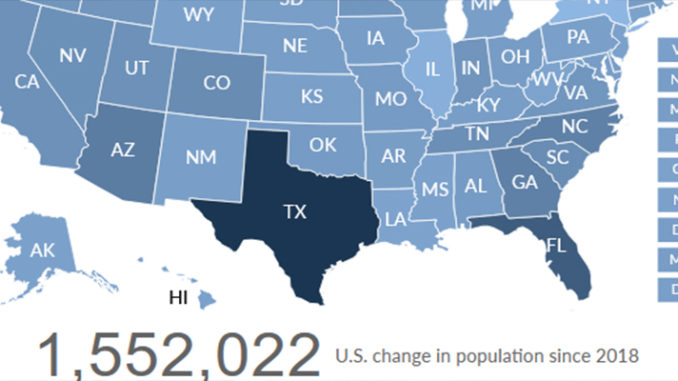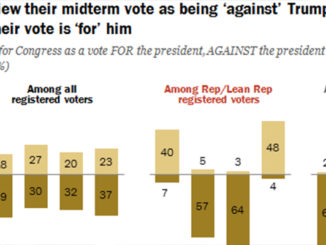
by Tim
Texas, Arizona and parts of the South are seeing the nation’s largest population bumps — and the people moving there from more liberal states may be feeding political change in those red-state conservative bastions.
As people from California and New York discover the South and Southwest, they’re finding friendly people and lower costs but aren’t sure how they’ll fit in politically.
“Politics is something I’ve learned not to discuss with the locals,” said Mimi O’Brien Reese, who moved from the New York City suburbs to Oak Island, North Carolina, in 2017. “It’s not my job to change the world so I just let it be. Where I live has a lot of transplants from New York, New Jersey and Connecticut, so I don’t feel out of place.”
There’s dispute over whether the newcomers will change state politics in the South, as they may have in North Carolina, which elected a Democratic governor in 2016, or are “leftugees” fleeing liberal policies who will embrace conservatism.
Republican Texas Gov. Greg Abbott made a point, in his State of the State address last year, of saying movers from other states were “fed up with big government policies increasingly running their lives and imposing burdensome regulations.”
Just five states accounted for most of the nation’s sluggish population increase of about 1.5 million between July 1, 2018 and July 1, 2019: Texas, Florida, Arizona, North Carolina and Georgia, according to U.S. Census Bureau estimates released in December. (The increase includes population growth through births, domestic migration and immigration.) All five states voted for Donald Trump in 2016, and they all have GOP-dominated state legislatures. North Carolina is the only one with a Democratic governor.
At the same time, population loss worsened in New York, which lost nearly 77,000 people.
California gained only about 51,000 residents, a fraction of the 336,000 it gained as recently as 2014. A new analysis by Kimball Brace, a Virginia political consultant, concluded that if census population estimates are correct, California will lose a seat in Congress to Texas, though a lot depends on how thoroughly residents are counted in this year’s census.
Texan friendliness was a big draw to Ping and John Bauer, who are planning a move this year from Orange County, California, once a Republican stronghold that has recently turned Democratic, to the Dallas suburb of Frisco. The couple, in their mid-50s — she considers herself Republican and he is independent — said they’re looking forward to more socializing with neighbors.
“I literally do not know the names of my neighbors after 10 years here [in California],” said John Bauer, who is originally from Ohio. “When we were out there getting the new house set up, we had two people in one day introduce themselves and say, ‘Hey, welcome to Texas!’”
The Bauers are moving to be near their daughter, who will attend college in Texas. John’s work as a business consultant allows him to live anywhere. Property taxes might be higher in the Lone Star State, but its lack of state income tax helps. And they’ll be able to trade a $925,000 house in California for a custom-built home, more than twice as big at 4,600 square feet, for about two-thirds of the cost.
Net movers to Texas from other states increased 50% to more than 125,000, according to the census estimates.
It was the only state to see such a large increase. Net movers to Georgia grew 24% to about 50,000, and movers to Idaho were up 14% to about 27,000.
Texas has been a magnet for movers recently as rising oil prices have boosted its economy, said Pia Orrenius, a labor economist for the Federal Reserve Bank of Dallas. But the state’s growing appeal also has made housing more expensive.
“We’re still more affordable than the large metros in New York and California, which is where we’ve been pulling the bulk of migration,” said Orrenius. “But we’re not as affordable compared to the rest of the nation as we were 10 years ago. It’s much harder to compete with the heartland.”
During the oil price bust of 2014-2016, Texas population growth slowed but never stopped, noted state demographer Lloyd Potter, as the state’s economy diversified to include more tech and knowledge industries.
The politics change when young people moving to urban areas within the red states where they grew up meet newcomers from other states and new immigrant cultures.
“If you look at some of the swing districts that have historically been solidly Republican, they’re becoming more competitive,” Potter said. Six Texas Republicans have retired from Congress ahead of this year’s election, and some of those seats may go to Democrats.
Young progressive movers tend to leave rural areas for Democratic cities, Potter said, and that also changes the politics. More than 90 Texas counties are losing population despite the overall boom, and they’re mostly in small towns or rural areas, Potter added.
Arrivals from other states are part of an equation that is challenging Republicans in Texas and other states in the South and Southwest, said Cal Jillson, a political science professor at Southern Methodist University in Dallas.
Democrats are slowly taking over, especially in suburbs where new residents include immigrants from Asia and Latin America moving out of urban areas, where residents tend to be more educated and affluent, Jillson said.
The 2018 election showed that those suburban voters were making Texas politics more unpredictable, he said. Democrats gained two seats in the state Senate and 12 seats in the House in key suburban districts, though Republicans kept a majority in both chambers.
“I thought it would take a couple of decades before Texas became competitive on a regular basis, but the process has sped up,” Jillson said. “Trump’s election and his personality have roiled the traditional Republican voters in the suburbs here.”
Even so, Trump is likely to carry Texas by a diminished margin after winning the state by 9 points in 2016, Jillson said, barring any further problems.
But some see Trump doing even better in Texas this year.
Chuck Devore, who was a Republican state legislator in California’s Orange County before moving to Texas in 2011, said Texans are even more likely to vote for Trump now because of the economy and the conservative judges he has appointed.
“People may have been suspicious before,” Devore said. “Now he has a track record that sits very well with the majority of Texans.”
The conservative Texas Public Policy Foundation is planning to poll residents to see whether newcomers are more likely to be Democrats. Some studies suggest many could be Republicans and independents, like the Bauers, coming from Republican suburban strongholds in other states, said Devore, vice president of the foundation.
In Georgia, a fast-growing African American population in the Atlanta suburbs, including many moving from other states, led to similar gains for Democrats in 2018.
Jillson said it’s common for New Yorkers and Californians new to the South to be reticent about talking politics until they get a sense of their neighbors, like O’Brien Reese.
“You’re a newcomer in an area, and you’re going to shut up and listen and learn, and then decide, ‘Am I going to put up a Biden sign in my front yard, based on what I hear?’ But the Democrats are going to find each other and talk,” Jillson said.
Joe Akin, who moved to the Houston suburb of Richmond with his wife in August from Warwick, New York, said he hasn’t broached the subject of politics with his neighbors, but he is happy with the affordability and nearby relatives from the Northeast.
“The taxes were lower, which is a big plus,” said Akin, who is in his mid-50s. “The traffic is still a big issue. It’s still really slow, just like in New York. But the difference is people don’t get mad — it’s just like, oh well, we’re in traffic, and they just stay in their lane and stay calm.”
.
Tim Henderson covers demographics for the Pew Trusts’ Stateline.




